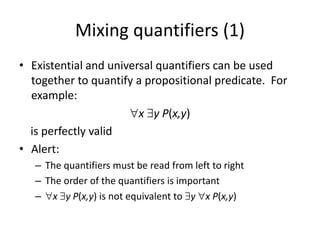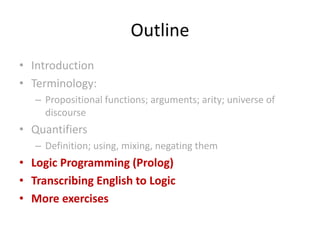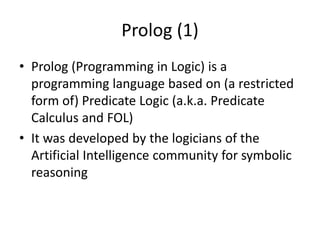Discrete Structure Lecture #5 & 6.pdf
- 1. Sindh Madressatul Islam University, Karachi Department of Computer Science Discrete Structure 3rd Semester Section E
- 2. Predicate Logic and Quantifies in Discrete Structure
- 3. Outline • Introduction • Terminology: – Propositional functions; arguments; arity; universe of discourse • Quantifiers – Definition; using, mixing, negating them • Logic Programming (Prolog) • Transcribing English to Logic • More exercises
- 4. Introduction • Consider the statements: x>3, x=y+4, x+y=z • The symbols >, +, = denote relations between x and 3, x, y, and 4, and x,y, and z, respectively • These relations may hold or not hold depending on the values that x, y, and z may take. • A predicate is a property that is affirmed or denied about the subject (in logic, we say ‘variable’ or ‘argument’) of a statement • Consider the statement : ‘x is greater than 3’ – ‘x’ is the subject – ‘is greater than 3’ is the predicate
- 5. Propositional Functions (1) • To write in Predicate Logic ‘x is greater than 3’ – We introduce a functional symbol for the predicate and – Put the subject as an argument (to the functional symbol): P(x) • Terminology – P(x) is a statement – P is a predicate or propositional function – x as an argument
- 6. Propositional Functions (2) • Examples: – Father(x): unary predicate – Brother(x,y): binary predicate – Sum(x,y,z): ternary predicate – P(x,y,z,t): n-ary predicate
- 7. Propositional Functions (3) • Definition: A statement of the form P(x1,x2,…, xn) is the value of the propositional symbol P. • Here: (x1,x2,…, xn) is an n-tuple and P is a predicate • We can think of a propositional function as a function that – Evaluates to true or false – Takes one or more arguments – Expresses a predicate involving the argument(s) – Becomes a proposition when values are assigned to the arguments
- 8. Propositional Functions: Example • Let Q(x,y,z) denote the statement ‘x2+y2=z2’ – What is the truth value of Q(3,4,5)? – What is the truth value of Q(2,2,3)? – How many values of (x,y,z) make the predicate true? Q(3,4,5) is true There are infinitely many values that make the proposition true, how many right triangles are there? Q(2,2,3) is false
- 9. Universe of Discourse • Consider the statement ‘x>3’, does it make sense to assign to x the value ‘blue’? • Intuitively, the universe of discourse is the set of all things we wish to talk about; that is the set of all objects that we can sensibly assign to a variable in a propositional function. • What would be the universe of discourse for the propositional function below be: EnrolledCSE235(x)=‘x is enrolled in CSE235’
- 10. Universe of Discourse: Multivariate functions • Each variable in an n-tuple (i.e., each argument) may have a different universe of discourse • Consider an n-ary predicate P: P(r,g,b,c)= ‘The rgb-values of the color c is (r,g,b)’ • Example, what is the truth value of – P(255,0,0,red) – P(0,0,255,green) • What are the universes of discourse of (r,g,b,c)?
- 11. Outline • Introduction • Terminology: – Propositional functions; arguments; arity; universe of discourse • Quantifiers – Definition; using, mixing, negating them • Logic Programming (Prolog) • Transcribing English to Logic • More exercises
- 12. Quantifiers: Introduction • The statement ‘x>3’ is not a proposition • It becomes a proposition – When we assign values to the argument: ‘4>3’ is false, ‘2<3’ is true, or – When we quantify the statement • Two quantifiers – Universal quantifier ∀ $forall$ the proposition is true for all possible values in the universe of discourse – Existential quantifier∃ $exists$ the proposition is true for some value(s) in the universe of discourse
- 13. Universal Quantifier: Definition • Definition: The universal quantification of a predicate P(x) is the proposition ‘P(x) is true for all values of x in the universe of discourse.’ We use the notation: ∀ x P(x), which is read ‘for all x’. • If the universe of discourse is finite, say {n1,n2,…,nk}, then the universal quantifier is simply the conjunction of the propositions over all the elements ∀ x P(x) ⇔ P(n1) ∧ P(n2) ∧ … ∧ P(nk)
- 14. Universal Quantifier: Example 1 • Let P(x): ‘x must take a discrete mathematics course’ and Q(x): ‘x is a CS student.’ • The universe of discourse for both P(x) and Q(x) is all UNL students. • Express the statements: – “Every CS student must take a discrete mathematics course.” – “Everybody must take a discrete mathematics course or be a CS student.” – “Everybody must take a discrete mathematics course and be a CS student.” ∀ x Q(x) → P(x) ∀ x ( P(x) ∨ Q(x) ) ∀ x ( P(x) ∧ Q(x) ) Are these statements true or false?
- 15. Universal Quantifier: Example 2 • Express the statement: ‘for every x and every y, x+y>10’ • Answer: – Let P(x,y) be the statement x+y>10 – Where the universe of discourse for x, y is the set of integers – The statement is: ∀x ∀y P(x,y) • Shorthand: ∀x,y P(x,y)
- 16. Existential Quantifier: Definition • Definition: The existential quantification of a predicate P(x) is the proposition ‘There exists a value x in the universe of discourse such that P(x) is true.’ We use the notation: ∃ x P(x), which is read ‘there exists x’. • If the universe of discourse is finite, say {n1,n2,…,nk}, then the existential quantifier is simply the disjunction of the propositions over all the elements ∃ x P(x) ⇔ P(n1) ∨ P(n2) ∨ … ∨ P(nk)
- 17. Existential Quantifier: Example 1 • Let P(x,y) denote the statement ‘x+y=5’ • What does the expression ∃x ∃y P(x,y) mean? • Which universe(s) of discourse make it true?
- 18. Existential Quantifier: Example 2 • Express the statement: ‘there exists a real solution to ax2+bx- c=0’ • Answer: – Let P(x) be the statement x= (-b±√(b2-4ac))/2a – Where the universe of discourse for x is the set of real numbers. Note here that a, b, c are fixed constants. – The statement can be expressed as ∃x P(x) • What is the truth value of ∃x P(x)? – It is false. When b2<4ac, there are no real number x that can satisfy the predicate • What can we do so that ∃x P(x)is true? – Change the universe of discourse to the complex numbers, C
- 19. Quantifiers: Truth values • In general, when are quantified statements true or false? Statement True when… False when... ∀x P(x) P(x) is true for every x There is an x for which P(x) is false ∃x P(x) There is an x for which P(x) is true P(x) is false for every x
- 20. Mixing quantifiers (1) • Existential and universal quantifiers can be used together to quantify a propositional predicate. For example: ∀x ∃y P(x,y) is perfectly valid • Alert: – The quantifiers must be read from left to right – The order of the quantifiers is important – ∀x ∃y P(x,y) is not equivalent to ∃y ∀x P(x,y)
- 21. Mixing quantifiers (2) • Consider – ∀x ∃y Loves (x,y): Everybody loves somebody – ∃y ∀x Loves(x,y): There is someone loved by everyone • The two expressions do not mean the same thing • (∃y ∀x Loves(x,y)) → (∀x ∃y Loves (x,y)) but the converse does not hold • However, you can commute similar quantifiers – ∀x ∀y P(x,y) is equivalent to ∀y ∀x P(x,y) (thus, ∀x,y P(x,y)) – ∃x ∃y P(x,y) is equivalent to ∃y ∃x P(x,y) (thus ∃x,y P(x,y))
- 22. Mixing Quantifiers: Truth values Statement True when... False when... ∀x∀y P(x,y) P(x,y) is true for every pair x,y There is at least one pair x,y for which P(x,y) is false ∀x∃y P(x,y) For every x, there is a y for which P(x,y) is true There is an x for which P(x,y) is false for every y ∃x∀y P(x,y) There is an x for which P(x,y) is true for every y For every x, there is a y for which P(x,y) is false ∃x∃yP(x,y) There is at least one pair x,y for which P(x,y) is true P(x,y) is false for every pair x,y
- 23. Outline • Introduction • Terminology: – Propositional functions; arguments; arity; universe of discourse • Quantifiers – Definition; using, mixing, biding, negating them • Logic Programming (Prolog) • Transcribing English to Logic • More exercises
- 24. Binding Variables • When a quantifier is used on a variable x, we say that x is bound • If no quantifier is used on a variable in a predicate statement, the variable is called free • Examples – In ∃x∀yP(x,y), both x and y are bound – In ∀xP(x,y), x is bound but y is free • A statement is called a well-formed formula, when all variables are properly quantified
- 25. Binding Variables: Scope • The set of all variables bound by a common quantifier is called the scope of the quantifier • For example, in the expression ∃x,y∀zP(x,y,z,c) – What is the scope of existential quantifier? – What is the scope of universal quantifier? – What are the bound variables? – What are the free variables? – Is the expression a well-formed formula?
- 26. Negation • We can use negation with quantified expressions as we used them with propositions • Lemma: Let P(x) be a predicate. Then the followings hold: ¬(∀x P(x)) ≡ ∃x ¬P(x) ¬ (∃x P(x)) ≡ ∀x ¬P(x) • This is essentially the quantified version of De Morgan’s Law (when the universe of discourse is finite, this is exactly De Morgan’s Law)
- 27. Negation: Truth Truth Values of Negated Quantifiers Statement True when… False when... ¬∃x P(x) ≡ ∀x ¬P(x) P(x) is false for every x There is an x for which P(x) is true ¬∀x P(x) ≡ ∃x ¬P(x) There is an x for which P(x) is false P(x) is true for every x
- 28. Outline • Introduction • Terminology: – Propositional functions; arguments; arity; universe of discourse • Quantifiers – Definition; using, mixing, negating them • Logic Programming (Prolog) • Transcribing English to Logic • More exercises
- 29. Prolog (1) • Prolog (Programming in Logic) is a programming language based on (a restricted form of) Predicate Logic (a.k.a. Predicate Calculus and FOL) • It was developed by the logicians of the Artificial Intelligence community for symbolic reasoning
- 30. Prolog (2) • Prolog allows the users to express facts and rules • Facts are propositional functions: student(mia), enrolled(mia,cse235), instructor(patel,cse235), etc. • Rules are implications with conjunctions: teaches(X,Y) :- instructor(X,Z), enrolled(Y,Z) • Prolog answers queries such as: ?enrolled(mia,cse235) ?enrolled(X,cse476) ?teaches(X,mia) by binding variables and doing theorem proving (i.e., applying inference rules) as we will see in Section 1.5
- 31. English into Logic • Logic is more precise than English • Transcribing English into Logic and vice versa can be tricky • When writing statements with quantifiers, usually the correct meaning is conveyed with the following combinations: Use ∀ with ⇒ ∀x Lion(x) ⇒ Fierce(x): Every lion is fierce ∀x Lion(x) ∧ Fierce(x): Everyone is a lion, and everyone is fierce Use ∃ with ∧ ∃ x Lion(x) ∧ Vegan(x): Holds when you have at least one vegan lion ∃ x Lion(x) ⇒ Vegan(x): Holds when you have vegan people in the universe of discourse (even though there is no vegan lion in the universe of discourse )






























